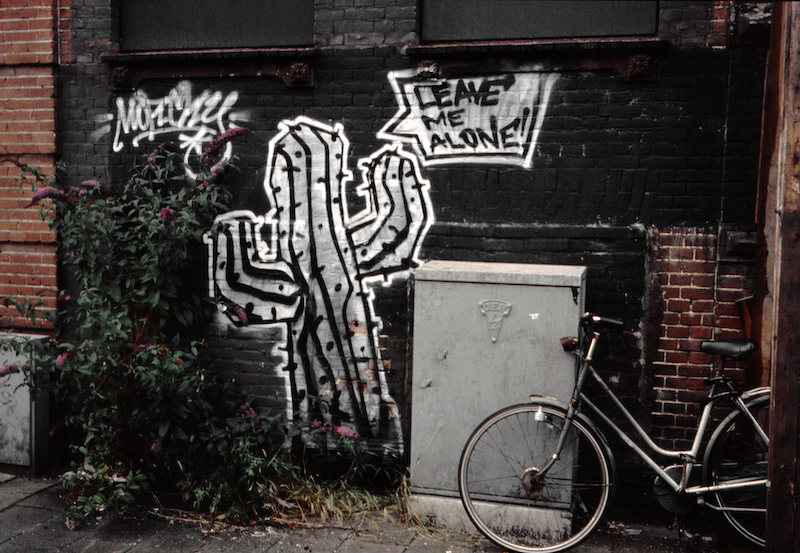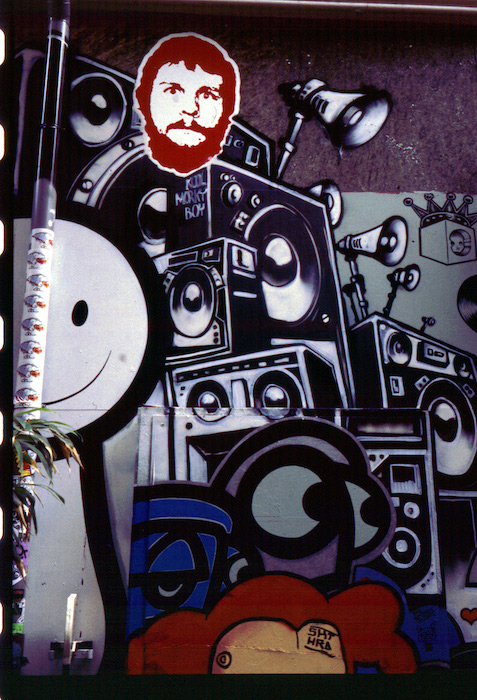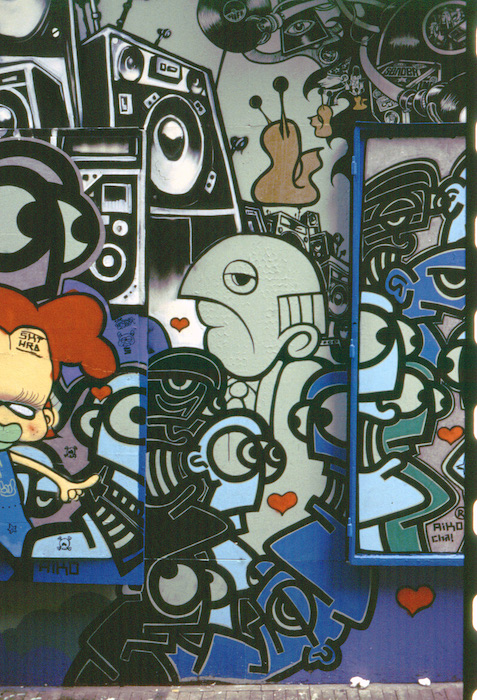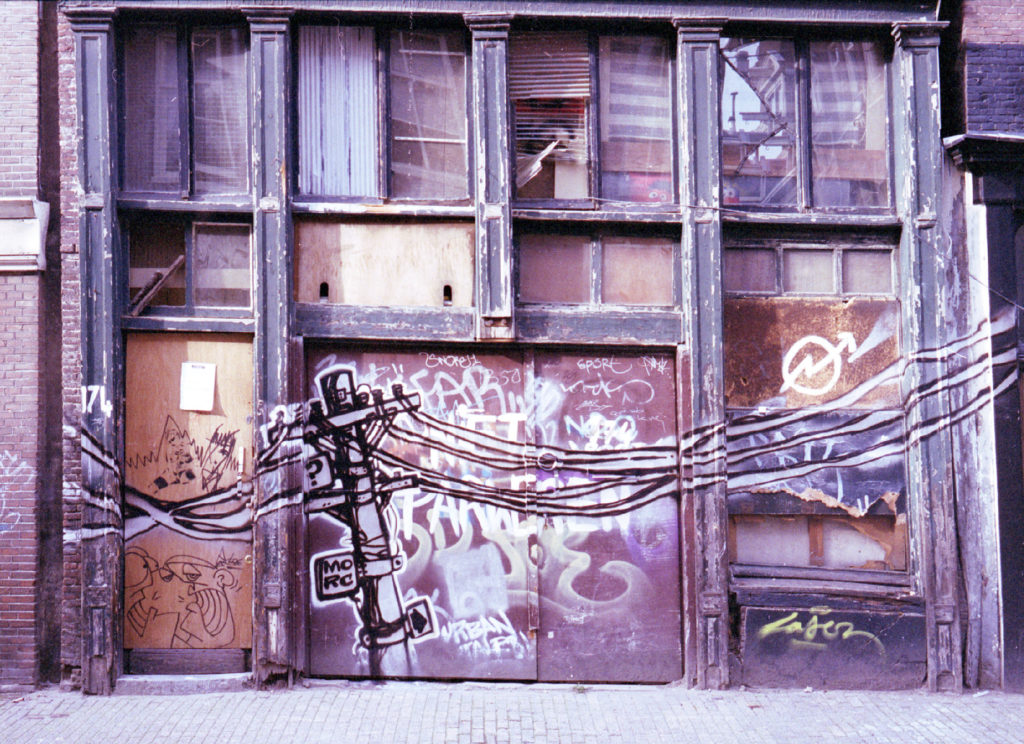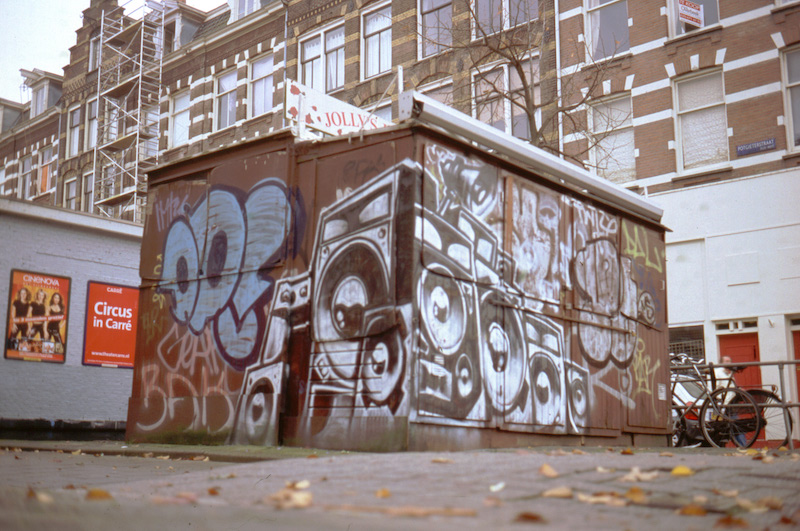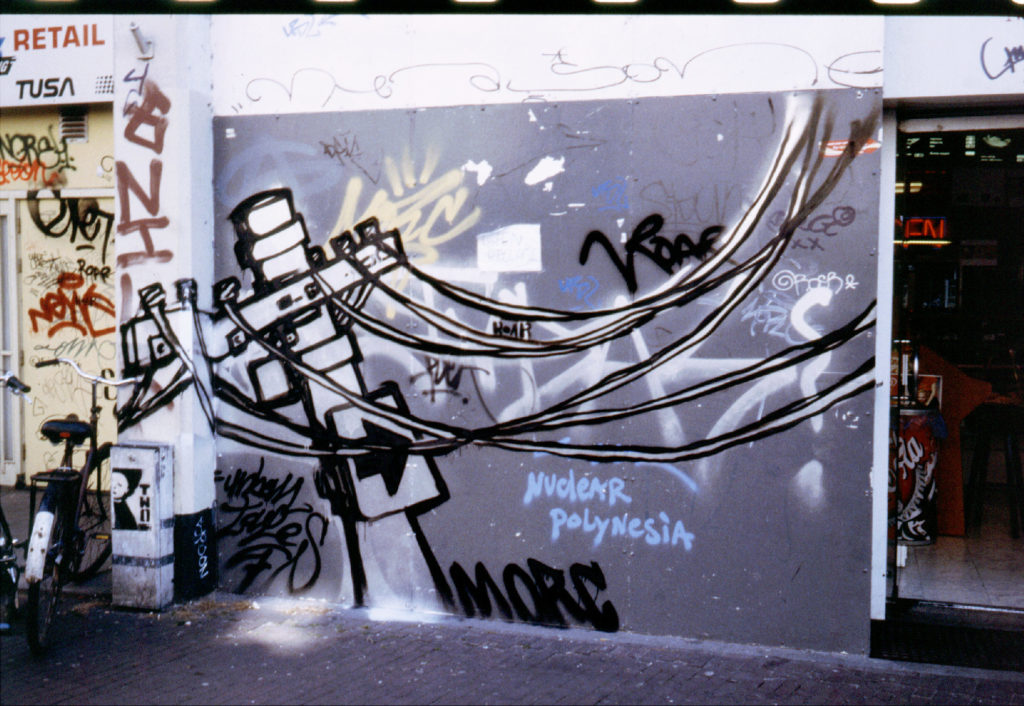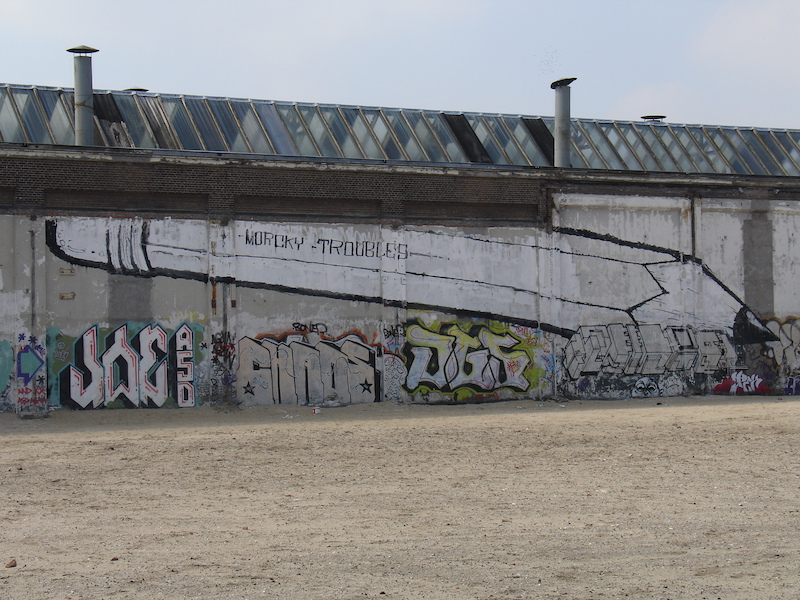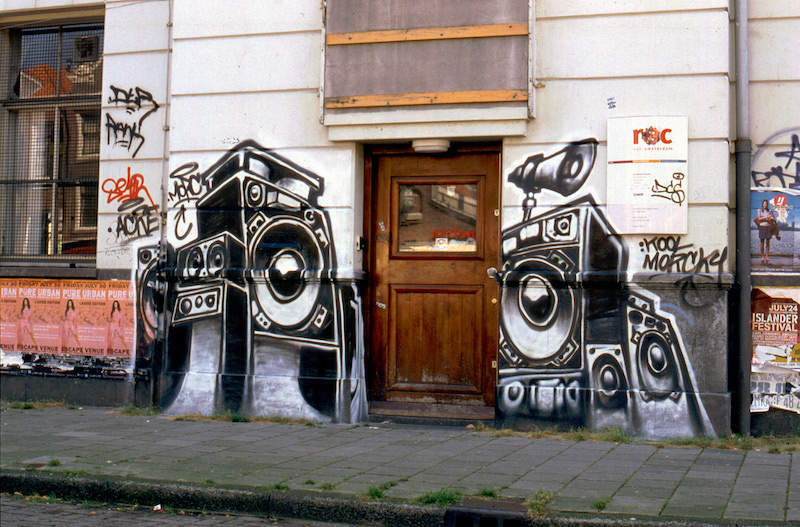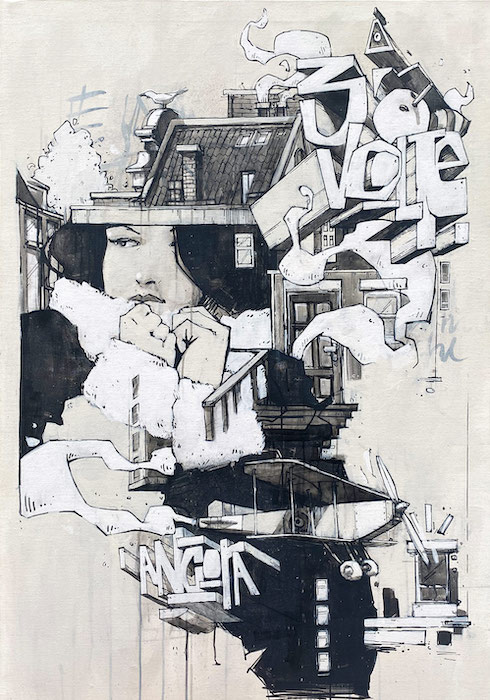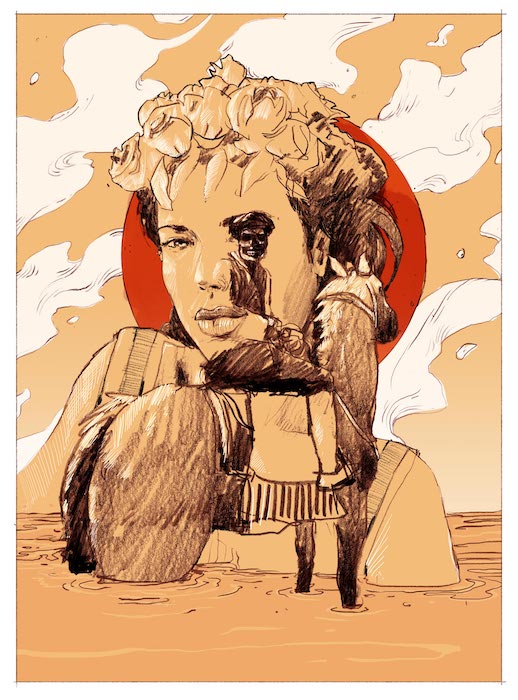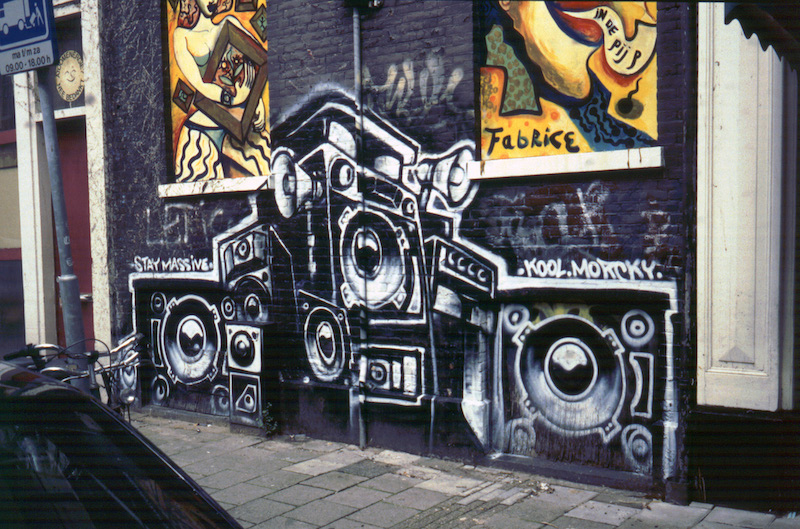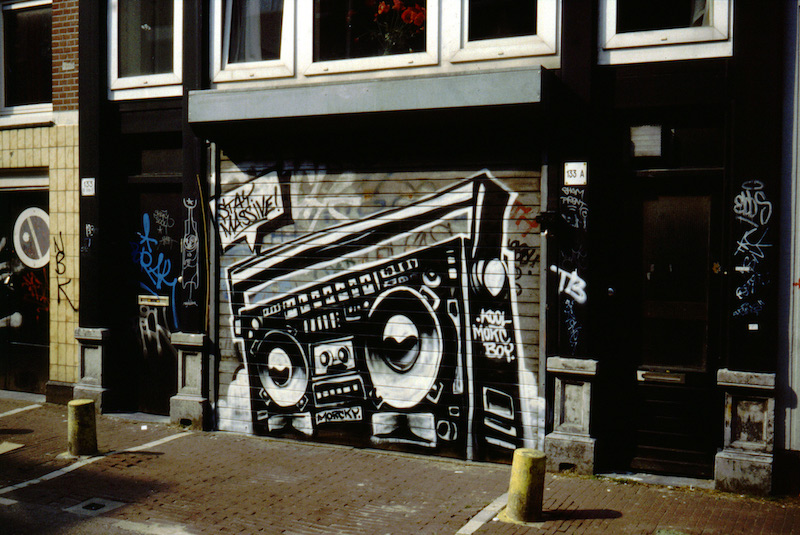Morcky moved to Amsterdam in 2002 for adventure’s sake. Amsterdam’s earlier generation of independent public artists inspired him to go back to painting figurative graffiti, as he did in Italy in the mid 90s. Eventually, Morcky channeled the inspiration he was getting from the streets of Amsterdam into new, more intimate artworks produced in his studio in Barcelona.
Morcky Moved to Amsterdam
When Morcky arrived in Amsterdam from Perugia, a postcard-pretty city in central Italy, he only had the contact of a woman who was living here for a few months. In a dynamically multicultural city like Amsterdam, that equals to pretty much nothing.
Moving away from his country definitely required a leap of faith, which he made together with his long-time friend and fellow graffiti writer The Boghe. They were 27 years old and they didn’t know what to expect from this city; they just felt it was the right place to be.
Amsterdam was – and still is – a city that embraces the future. Unlike in Italy, where the past is worshiped and whatever breaks with it becomes a difficulty, here new things are welcomed, even encouraged.
The city was the vanguard in so many things, among which graffiti. In the 1980s and 1990s Delta, Shoe, Zedz, Cat22, and fellow graffiti writers from Amsterdam were writing their names all around Europe. Amsterdam’s exposure to international graffiti culture (writers like Futura, Dondi and Seen exhibited in Amsterdam already in the 80s) automatically set them among the founders of the graffiti movement in Europe.
Read also: A Short Introduction to Graffiti and Street Art in Amsterdam
Morcky too was deeply absorbed in graffiti, although he did experience his entire classic graffiti phase (1989 – 2000) from a provincial city in central Italy. Back then, he was living graffiti with a more “dreamlike” mindset than his fellow writers from the metropolis, although he did travel as often as possible eager to see what and how everybody else was painting.
That drastically changed when he moved to the international city par excellence: Amsterdam. Here, Morcky quickly found a multicultural community of artists that turned out to be the main inspiration of his artistic production, both on and off the streets.
The openness of Amsterdam is exactly what kept him here for such a long time, together with the fact that this city combines the intimate feeling of a small community with the multiple inputs and the creative energy of an international metropolis.
“When I arrived here I was experimenting with everything: from video to animations, illustrations, photography. I was trying to mix them all in a language of my own. Then, after one year, I began drawing again. This city inspired me, Amsterdam’s people inspired me: suddenly, I was painting in the streets again.”
Morcky
Morcky and the Early Generation of Street Artists in Amsterdam
Inspiration came to Morcky not only from the city, but also from the people he met in Amsterdam. The scene was so small and tight-knit that it didn’t take Morcky long to meet all the other artists who, like him, had begun hitting the streets differently from the previous generation of classic graffiti writers.
From 2004 on, Morcky painted with Sitnie, Zender, ZEDZ, Raymond Lemstra, Via Via, Galo, Niko Stumpo, and many more. Mostly, he was hanging out with Wayne Horse and The London Police, who also had moved to Amsterdam in the same years (respectively from Germany and from the UK).
They shared thousands of adventures, projects, drawings, trips, and countless tins of black paint in a time (1998 – 2010) when the scene was definitely wilder – so wild that even the name “street art” wasn’t there yet.
There were more people out painting and they were painting more, but they were all mostly painting illegally. Painting for the sake of it, without even thinking about gallery shows and commissioned walls – let alone social media – was the essence of the statement of this young generation of Amsterdam’s independent public artists. Their voice in the streets was true artistic freedom.
“Painting illegally is like a performance. It’s something you must do within a certain amount of time. You might have 10 minutes, or even 5 minutes, and in that amount of time you should do something knowing that you can’t erase it or take it back if you make a mistake. So it’s fundamental to have a clear idea of what you are going to paint and how you are going to paint it, to know what colors you will use and have them ready in your pocket.”
Morcky
The total freedom of expressing his artist’s statement in the streets didn’t mean unpreparedness, though. The act of painting illegally always requires good planning, especially for Morcky, who cared about his spots to the point that he considered them part of his artist’s statement.
Morcky researched his spots in advance, making sure that they had the expected impact on how, when, and who was stumbling upon one of his drawings. Because, once again, being able to freely determine all those variables of how people were affected by his art was what made painting in the streets so important –even cathartic- for Morcky.
Morcky and the Beginning of Figurative Graffiti
“I’ve never been a purist of lettering and I’ve always loved to draw. I’ve experimented with characters, puppets and more figurative shapes since the early days of graffiti, because sometimes letters were not enough for me.”
Morcky
Nowadays, Morcky works with the human figure as part of his vocabulary but back then, he was inspired by objects instead. They were less explicit; they didn’t come with a suitcase full of emotions and they could still perfectly symbolize human activities and feelings.
Over a few years (2004 – 2010), Morcky painted all around Amsterdam several signature-figures. It all began in 2004, when he realized that electricity poles were for him -an artist living in a city- what trees were for an old landscape painter. What fascinated him the most was that electricity poles were changing organically, together with the city. Finally, they were also an invitation to see beauty wherever you look.
Many other symbolic objects have followed, among which a somehow intimate representation of his daily life through two objects that are very common for artists: a pencil and a pencil sharpener.
Perhaps the most iconic series of figurative graffiti he has ever done in Amsterdam were the Boombox speakers. They stood for the pure energy of music, which can touch you on a deeper level.
Most of these drawings are long gone, but the inspiration for his videos, his graphic novels (he published his first book in 2010 and his second book in 2012), his illustrations and many more projects that followed all come from the same place as these drawings: his inner world.
Morcky is still painting in the streets, and he is even still doing so with the very same people, whenever he is back in Amsterdam. However, since 2015, he is based in Barcelona, where he carries on a more intimate work.
In his studio in Barcelona, Morcky achieved the perfect balance between the geometric accuracy of graphic cityscapes and his instinctive freehand drawing. The first series he created in Barcelona focused on the urban landscapes of his new hometown, followed by a series of emotional portraits exploring the inner worlds of his characters.
Morcky is now working on a series that puts together the different themes he explored in his Barcellona years – architecture, portraits, and lettering – to tell one complete story with a dreamlike and emotional narrative. The personal research behind it, though, is the same driving force that had brought him onto the streets of Amsterdam many years ago.
Morcky and Street Art as a Performance
Being it either the readers of his graphic novels or the passersby that stumble upon his art in the streets, the dialogue with the public is critical for Morcky. It’s the ultimate reason why he is painting. It has nothing to do with exhibitionism, more so with connecting with an audience: the people whom he aims to provoke, surprise or otherwise impact.
“When you paint in the street you are like a performer. One thing is writing a song and another thing is doing a concert. When you go on stage, you are in the spotlight; you are putting yourself on the line. The public will then judge you: they will have an opinion, either good or bad, about your artist’s statement and your art”
Morcky
Morcky met all kinds of people while he was painting in the streets of Amsterdam, from those who immediately called the police to the more enthusiastic ones who were walking back home after a party.
The internet was already a thing, but it surely didn’t represent artists’ main public, as it does now. Reflecting on this huge difference, Morcky likes to stress the fact that interactions on social media – despite allowing you to reach a potentially bigger public – are colder because they aren’t sparkling from the magic of the performance.
If you are missing the performance, you are missing the whole thing: it’s like watching a concert from the screen of your phone rather than actually being there, next to the Boombox speakers.
“What I really liked was the act of painting in the streets. I respect those who do stickers, stencils, posters and all those things, but for me street art is the unique gesture that happens in that specific time and at that specific place. It’s the movement of your hand, it’s the stress, it’s the limited amount of time and it’s the surroundings. That’s what makes it unique and, frankly, the magic of the performance is also the best part of it.”
Morcky
In the graffiti world, one of the main reasons for painting trains is that trains travel. Trains bring your piece from one place to another and, although today’s social media undoubtedly can make a piece ‘travel’ faster, looking at random photos while browsing the internet isn’t the same thing as a 6-meter long piece on a train suddenly driving past you. Neither it is as magical as being exactly in a place, let’s say in the streets of Amsterdam, at a very specific time, such as from 2002 to 2010, together with that inspirational bunch of people that Morcky happened to meet here.
All photos are from the artist’s archive

